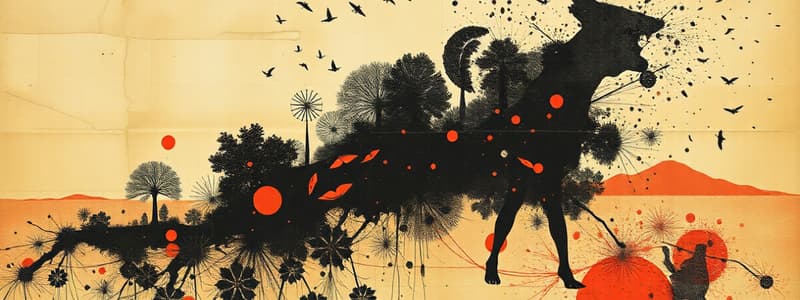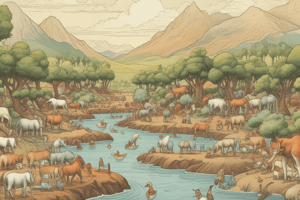Podcast
Questions and Answers
Which age-structure diagram would indicate a rapidly growing population?
Which age-structure diagram would indicate a rapidly growing population?
- More reproductive and postreproductive individuals than prereproductive individuals.
- More postreproductive individuals compared to prereproductive individuals.
- An equal number of prereproductive and reproductive individuals.
- More prereproductive and reproductive individuals than postreproductive individuals. (correct)
What type of distribution do emperor penguins exhibit around their nests?
What type of distribution do emperor penguins exhibit around their nests?
- Clumped distribution, reflecting proximity to resources.
- Random distribution, indicating haphazard nesting.
- Uniform distribution, due to defined territorial boundaries. (correct)
- Dense distribution due to high population density.
What does a clumped distribution of parrot fish near coral reefs signify?
What does a clumped distribution of parrot fish near coral reefs signify?
- Fish are migrating independently from each other.
- Fish are randomly scattered in the vicinity.
- Fish are equally spaced across the reef.
- Fish are grouped based on food availability and predator protection. (correct)
What is the primary definition of an organism's biotic potential?
What is the primary definition of an organism's biotic potential?
Which population has the highest biotic potential based on reproductive rates?
Which population has the highest biotic potential based on reproductive rates?
Which characteristic is crucial for a biotic potential to be effectively measured?
Which characteristic is crucial for a biotic potential to be effectively measured?
In ecological terms, what is the significance of a uniform distribution?
In ecological terms, what is the significance of a uniform distribution?
What would an age-structure diagram resembling a pyramid indicate about a population?
What would an age-structure diagram resembling a pyramid indicate about a population?
What is the primary factor that defines biotic potential in a population?
What is the primary factor that defines biotic potential in a population?
Which scenario best exemplifies exponential growth in a population?
Which scenario best exemplifies exponential growth in a population?
How many individuals will be in a population of squirrels after 3 years if it starts with 200 individuals and has a 10% growth rate per year?
How many individuals will be in a population of squirrels after 3 years if it starts with 200 individuals and has a 10% growth rate per year?
Which of the following statements is NOT true for both logistic and exponential growth?
Which of the following statements is NOT true for both logistic and exponential growth?
What does it mean when a population stabilizes at a certain number, such as 45 individuals in Jacob's study of wrens?
What does it mean when a population stabilizes at a certain number, such as 45 individuals in Jacob's study of wrens?
In the context of increased competition for food during drought years, this phenomenon is classified as what type of factor?
In the context of increased competition for food during drought years, this phenomenon is classified as what type of factor?
The spread of a virus among honeybee populations is an example of which ecological factor?
The spread of a virus among honeybee populations is an example of which ecological factor?
Which of the following is a characteristic of equilibrium species?
Which of the following is a characteristic of equilibrium species?
What term describes different populations living in the same geographical area?
What term describes different populations living in the same geographical area?
What type of ecology focuses on the study of interactions between species in a defined area?
What type of ecology focuses on the study of interactions between species in a defined area?
When a small number of butterflies are introduced to a previously uninhabited island with ample resources, what potential growth pattern might they exhibit?
When a small number of butterflies are introduced to a previously uninhabited island with ample resources, what potential growth pattern might they exhibit?
What phase follows the rapid increase in population during logistic growth?
What phase follows the rapid increase in population during logistic growth?
Which of the following environmental factors is considered density-independent?
Which of the following environmental factors is considered density-independent?
What describes a population's ability to sustain growth indefinitely without resource limitation?
What describes a population's ability to sustain growth indefinitely without resource limitation?
What term describes the butterflies and flowers living on a barrier island in Florida?
What term describes the butterflies and flowers living on a barrier island in Florida?
To achieve the greatest population growth in the village of Hopkins, Belize, what should they focus on increasing?
To achieve the greatest population growth in the village of Hopkins, Belize, what should they focus on increasing?
Which of the following would most accurately be classified as a community?
Which of the following would most accurately be classified as a community?
Identify which option represents an ecosystem.
Identify which option represents an ecosystem.
In the context of community diversity, which is the least diverse community?
In the context of community diversity, which is the least diverse community?
Ecological succession refers to what?
Ecological succession refers to what?
Which statement best describes the first pioneer species in secondary succession?
Which statement best describes the first pioneer species in secondary succession?
Select the option that exemplifies primary succession.
Select the option that exemplifies primary succession.
Which scenario depicts a mutualistic relationship?
Which scenario depicts a mutualistic relationship?
Which of the following would NOT be considered a community?
Which of the following would NOT be considered a community?
Which of the following best describes species richness?
Which of the following best describes species richness?
What is a characteristic of equilibrium species during ecological succession?
What is a characteristic of equilibrium species during ecological succession?
What role do herbivores play in an ecosystem?
What role do herbivores play in an ecosystem?
Which interaction describes predation?
Which interaction describes predation?
Flashcards
Age Structure Diagram
Age Structure Diagram
A graphical representation of the distribution of individuals within a population according to their age groups, usually categorized as pre-reproductive, reproductive, and post-reproductive.
Rapidly Growing Population
Rapidly Growing Population
A population that has a high birth rate and low death rate, resulting in a significant increase in population size over time.
Uniform Distribution
Uniform Distribution
A pattern of distribution where individuals are evenly spaced apart, creating a regular and predictable spacing within the population.
Clumped Distribution
Clumped Distribution
Signup and view all the flashcards
Biotic Potential
Biotic Potential
Signup and view all the flashcards
Factors Affecting Biotic Potential
Factors Affecting Biotic Potential
Signup and view all the flashcards
Reproductive Rate
Reproductive Rate
Signup and view all the flashcards
Generation Time
Generation Time
Signup and view all the flashcards
Community
Community
Signup and view all the flashcards
Population Growth
Population Growth
Signup and view all the flashcards
Community
Community
Signup and view all the flashcards
Ecosystem
Ecosystem
Signup and view all the flashcards
Species Diversity
Species Diversity
Signup and view all the flashcards
Least Diverse
Least Diverse
Signup and view all the flashcards
Ecological Succession
Ecological Succession
Signup and view all the flashcards
Pioneer Species
Pioneer Species
Signup and view all the flashcards
Primary Succession
Primary Succession
Signup and view all the flashcards
Secondary Succession
Secondary Succession
Signup and view all the flashcards
Mutualistic Relationship
Mutualistic Relationship
Signup and view all the flashcards
Camouflage
Camouflage
Signup and view all the flashcards
Exponential Growth
Exponential Growth
Signup and view all the flashcards
Logistic Growth
Logistic Growth
Signup and view all the flashcards
Carrying Capacity
Carrying Capacity
Signup and view all the flashcards
Density-Dependent Factor
Density-Dependent Factor
Signup and view all the flashcards
Density-Independent Factor
Density-Independent Factor
Signup and view all the flashcards
Equilibrium Species
Equilibrium Species
Signup and view all the flashcards
What type of growth would a population of butterflies exhibit if they were introduced to an island with abundant resources and no predators?
What type of growth would a population of butterflies exhibit if they were introduced to an island with abundant resources and no predators?
Signup and view all the flashcards
Give an example of a density-dependent factor affecting a population.
Give an example of a density-dependent factor affecting a population.
Signup and view all the flashcards
How does logistic growth differ from exponential growth?
How does logistic growth differ from exponential growth?
Signup and view all the flashcards
Why is it important to consider both density-dependent and density-independent factors when studying population growth?
Why is it important to consider both density-dependent and density-independent factors when studying population growth?
Signup and view all the flashcards
What is the relationship between carrying capacity and logistic growth?
What is the relationship between carrying capacity and logistic growth?
Signup and view all the flashcards
What is the difference between a community and an ecosystem?
What is the difference between a community and an ecosystem?
Signup and view all the flashcards
Study Notes
Population Growth and Structure
- Age-structure diagrams: A rapidly growing population exhibits a higher proportion of reproductive and pre-reproductive individuals compared to post-reproductive ones, resembling a pyramid shape. This suggests a higher birth rate than death rate.
Spatial Distribution Patterns
- Uniform distribution: Animals defending territories of a specific size, exhibiting an even spacing, like emperor penguins.
- Clumped distribution: Organisms grouping together, often due to resource availability, like parrotfish near coral reefs.
Population Growth Factors
- Biotic potential: The maximum rate of population growth under ideal conditions. It depends on various factors like the organism's reproduction rate, age at sexual maturity, and offspring production. A higher biotic potential signifies faster growth.
- Exponential growth phase: The population growth accelerates when resources are plentiful.
- Logistic growth: Population growth slows as resources become limiting, eventually reaching a stable equilibrium or carrying capacity.
Carrying Capacity
- Carrying capacity: The maximum population size that can be sustained by available resources in a given environment.
Limiting Factors
- Density-dependent factors: Limiting factors whose impact increases as population density grows, including competition for resources, predation, and disease.
- Density-independent factors: Limiting factors that affect populations regardless of their density, including natural disasters (e.g., fires, floods).
Population Interactions
- Community: A group of different populations living and interacting in the same area. This involves community ecology and species interactions.
- Ecosystem: A community of organisms interacting with their physical environment. A broader ecological concept including all organisms and abiotic factors.
- Diversity: Ecological diversity is influenced by species richness and evenness, and it can affect the resilience and stability of ecosystems.
Ecological Succession
- Ecological succession: An orderly process of change in community structure over time.
- Primary succession: occurs on initially barren areas (e.g., volcanic rock, bare lava flows).
- Secondary succession: occurs after a disturbance in an established community (e.g., forest fire).
Mutualistic Relationships
- Mutualism: A type of interaction where two species benefit from their relationship. An example: crabs decorating their shells with sea anemones for camouflage and food availability.
Studying That Suits You
Use AI to generate personalized quizzes and flashcards to suit your learning preferences.




